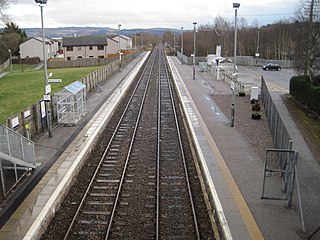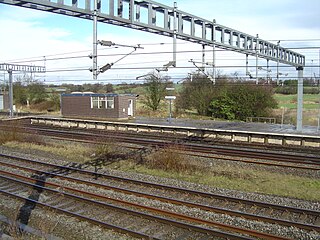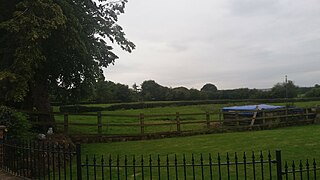
Stoke-on-Trent railway station is a mainline railway station serving the city of Stoke-on-Trent. It lies on the Stafford to Manchester branch of the West Coast Main Line. The station also provides an interchange between various local services running through Cheshire, Staffordshire and Derbyshire.

Stafford railway station is a major interchange railway station in Stafford, Staffordshire, England, and is the second busiest railway station in Staffordshire, after Stoke-on-Trent. The station serves the county town, as well as surrounding villages. The station lies on the junction of the Trent Valley Line, the Birmingham Loop/Rugby-Birmingham-Stafford Line, and the West Coast Main Line.
The Stafford and Uttoxeter Railway was authorised by Act of Parliament on 29 July 1862, to build a line between the towns of Stafford and Uttoxeter in Staffordshire, England. It opened for traffic in 1867. It opened on 23 December 1867. Construction cost had much exceeded estimates, and income was poor, so that the Company was always in financial difficulty. It was placed in receivership in 1875. The Great Northern Railway (GNR) had running powers to Uttoxeter and was persuaded to acquire the Company, which it did in 1881. The GNR spent a considerable sum on improving the line, but it never made money and it was closed to passengers on 4 December 1939. Goods traffic ceased in 1951, except for a short stub to RAF Stafford; this too closed in 1975.

Uttoxeter railway stationpronounced (listen) (help·info) is a station serving the town of Uttoxeter in Staffordshire, England on the Crewe-Derby Line, which is also a Community rail line known as the North Staffordshire line. The station is owned by Network Rail and managed by East Midlands Railway.

Muir of Ord railway station is a railway station on the Kyle of Lochalsh Line and the Far North Line, serving the village of Muir of Ord in the Highland council area of Scotland. The station is 13 miles 4 chains from Inverness, between Beauly and Conon Bridge, and is the location of the sole remaining passing loop on the single line between Dingwall and Inverness.

Norton Bridge railway station was a railway station located 4 miles (6.4 km) north-west of Stafford on the West Coast Main Line near the village of Norton Bridge, Staffordshire, England.
The Derbyshire and Staffordshire extension of the Great Northern Railway was an English railway network built by the GNR to get access to coal resources in the area to the north and west of Nottingham. The Midland Railway had obstructed the GNR in its attempts to secure a share of the lucrative business of transporting coal from the area, and in frustration the GNR built the line. The line was forked: it reached Pinxton in 1875 and a junction with the North Staffordshire Railway at Egginton, approaching Burton on Trent in 1878. The line cut through Derby, resulting in considerable demolition of housing there.

Derby Friargate railway station was the main station in Derby on the Great Northern Railway Derbyshire Extension, popularly known as the (Derby) Friargate Line.

Stone railway station serves the town of Stone, Staffordshire, England. The station is located on a junction of the Colwich to Manchester spur of the West Coast Main Line, but has platforms only on the branch from Stafford to Stoke-on-Trent.

Dunstall Park railway station was a station north of Wolverhampton Low Level railway station on the Great Western Railway's London Paddington to Birkenhead via Birmingham Snow Hill line. The station opened on 1 December 1896. Stafford Road engine shed and works and Oxley shed were nearby. It saw high traffic due to the nearby Wolverhampton Racecourse but closed in 1968 when services between Wolverhampton and Shrewsbury were switched to Wolverhampton High Level.

Ashbourne railway station formerly served the town of Ashbourne in Derbyshire. There have been two stations in the town. The first, opened in 1852, was operated by the North Staffordshire Railway (NSR); it was replaced in 1899 by a station at a new location, jointly operated by the NSR and the London and North Western Railway (LNWR). In 1923 the station passed into the ownership of the London, Midland and Scottish Railway and in 1948 that of the London Midland Region of British Railways. It was finally closed to all traffic in 1963.

New Basford railway station was a station in Nottingham on the Great Central Railway main line, the last main line to be built from the north of England to London. The station opened with the line on 15 March 1899.

Bulwell Common railway station was a station in Nottingham on the Great Central Railway main line, the last main line to be built from the north of England to London. The station opened with the line on 15 March 1899.

Grindley railway station was a former British railway station to serve the village of Grindley in Staffordshire.

Chartley railway station was a former British railway station to serve the village of Stowe-by-Chartley in Staffordshire.

Ingestre and Weston railway station was a former British railway station to serve the village of Ingestre in Staffordshire.

Sandon railway station was a railway station opened by the North Staffordshire Railway to serve the village of Sandon, Staffordshire, England.
Salt and Sandon railway station was a former British railway station opened by the Stafford and Uttoxeter Railway to serve the village of Salt in Staffordshire in 1867.

Denstone railway station is a former station of the North Staffordshire Railway's (NSR) Churnet Valley Line which served the village of Denstone in Staffordshire.
Whitmore was a station serving the village of Whitmore, Staffordshire.
















